Why Missing Draft Stopping in New Construction Is a Serious Issue
During a recent pre-drywall home inspection in Las Vegas, I came across a common but often overlooked issue: missing draft stopping. While it might sound like a minor problem, draft stopping plays a critical role in fire safety and energy efficiency. Unfortunately, it’s an issue that is often missed when new homes go up quickly. This is one of the many reasons why having a professional pre-drywall inspection is so important during new construction.
What Is Draft Stopping?
Draft stopping involves placing materials—usually drywall, OSB, or other fire-resistant materials—in concealed spaces like wall cavities, floors, and attics to slow the spread of fire and smoke. These materials are installed to block air movement, especially in large open areas between floors or within attics.
In new construction, it’s common to see open framing before insulation and drywall are installed. If draft stopping is not properly installed at this stage, it becomes much harder to detect and correct once the home is finished.
Why It Matters
1)Fire Safety: One of the primary purposes of draft stopping is to slow the spread of fire and smoke. In a fire situation, open cavities in walls and floors can allow flames to move quickly through a home, giving residents less time to escape and firefighters less time to respond. Proper draft stopping helps compartmentalize the structure and limit this risk.
2) Code Compliance: Building codes, including those enforced here in Las Vegas and across Nevada, require draft stopping in specific locations, especially in concealed floor and ceiling spaces. If it's missing, the home may not meet local code requirements, which can cause delays in closing or even force expensive repairs down the road.
3) Energy Efficiency: Draft stopping also helps control air flow within the home. When these barriers are missing, air can move freely between floors or into attic spaces, making it harder to maintain consistent indoor temperatures. This leads to higher energy bills and decreased comfort for future homeowners.
4) Pest Control: Open voids without draft stopping can also become pathways for pests like rodents or insects. Once they get into concealed spaces, they can be hard to detect and even harder to remove.
How a Pre-Drywall Home Inspection Helps
A pre-drywall inspection is one of the most critical phases in a new construction home inspection. It takes place after framing, plumbing, electrical, and HVAC rough-ins are complete, but before insulation and drywall are installed. This timing allows the inspector to see parts of the home that will soon be hidden.
During this stage, a licensed home inspector can identify missing draft stopping and many other issues that won’t be visible once construction progresses. Catching the problem early means it can be fixed easily and inexpensively. Waiting until after drywall is installed often means cutting into finished walls and ceilings, which adds time and cost.
Final Thoughts
If you're building a new home in Las Vegas, don't skip the pre-drywall inspection. Issues like missing draft stopping are more common than many people realize, and they can have serious implications for safety, comfort, and code compliance. A detailed inspection during this phase gives you peace of mind that your new home is being built to the highest standards.
As a certified home inspector in Las Vegas, I’ve seen firsthand how valuable these early inspections can be. If you’re in the process of building, contact me to schedule a pre-drywall inspection. It's one of the smartest steps you can take to protect your investment.
